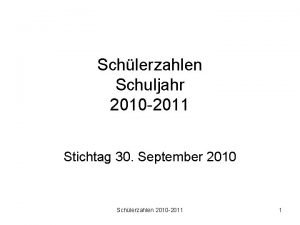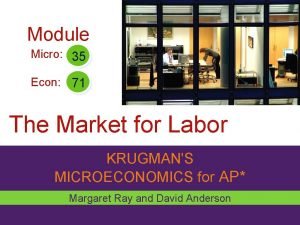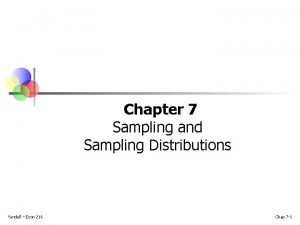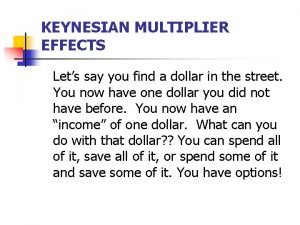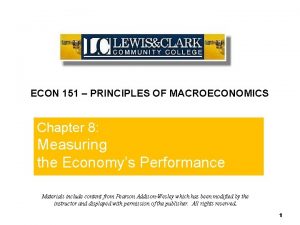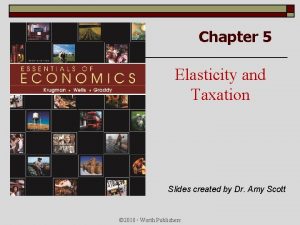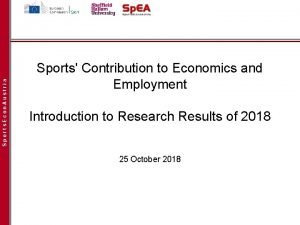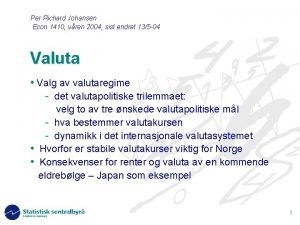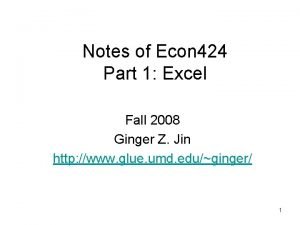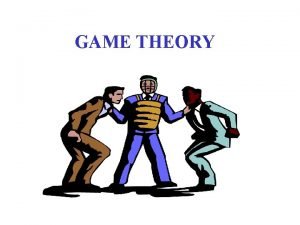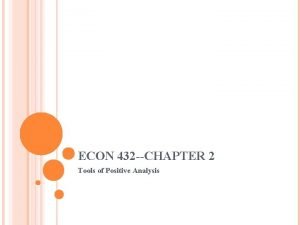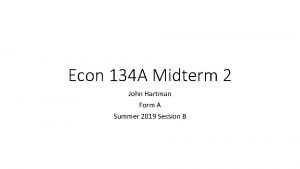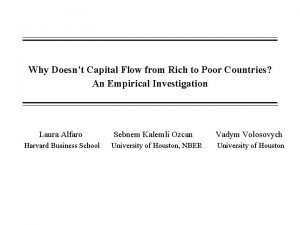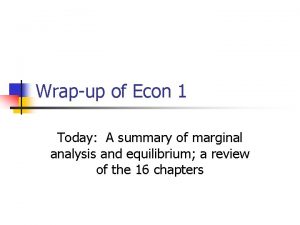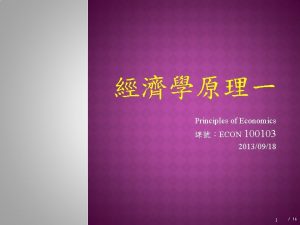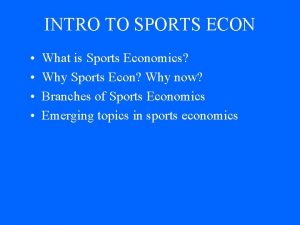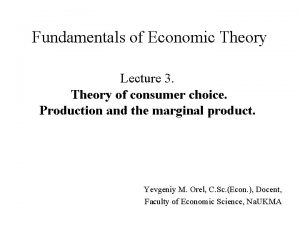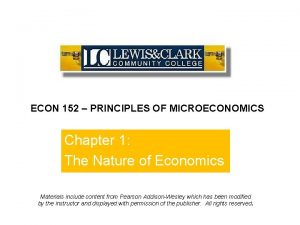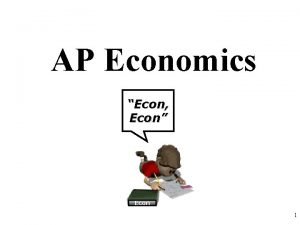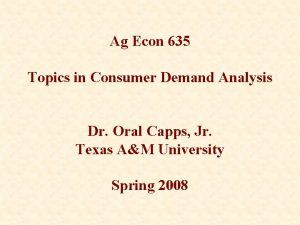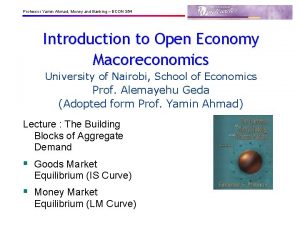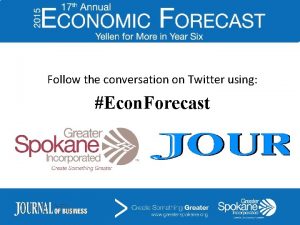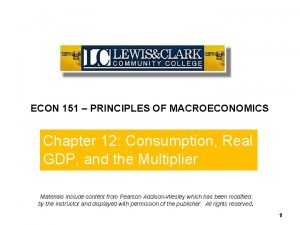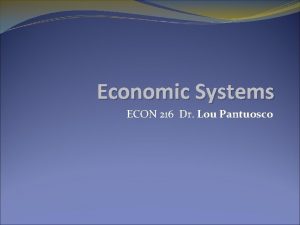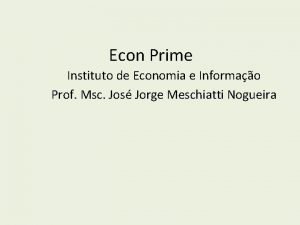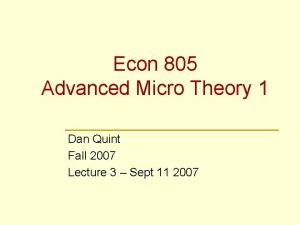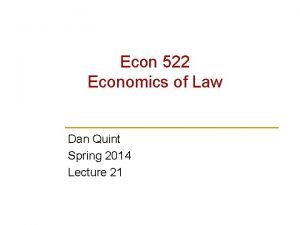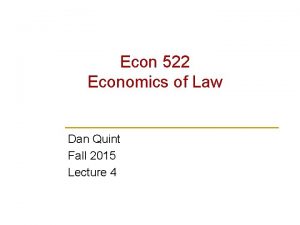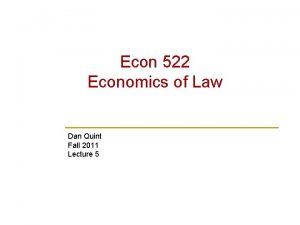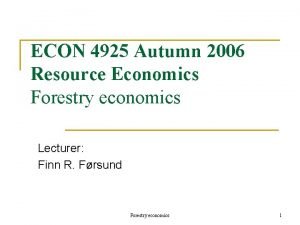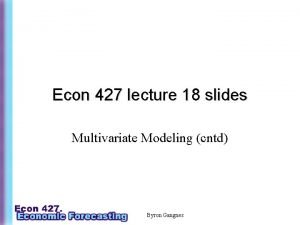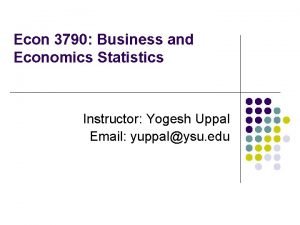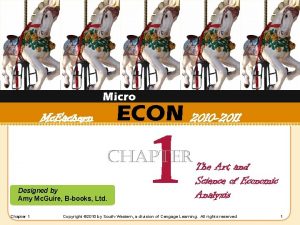Micro Mc Eachern ECON 12 2010 2011 CHAPTER















































- Slides: 47

Micro Mc. Eachern ECON 12 2010 -2011 CHAPTER Labor Markets Designed by Amy Mc. Guire, B-books, Ltd. Chapter 12 and Labor Unions Copyright © 2010 by South-Western, a division of Cengage Learning. All rights reserved 1

Labor Supply § Individual labor supply – Willing and able – Many possible uses – Over the realistic range of wages – Depends on • Abilities • Tastes • Opportunity cost LO 1 Chapter 12 Copyright © 2010 by South-Western, a division of Cengage Learning. All rights reserved 2

Labor Supply and Utility Maximization LO 1 Chapter 12 § Utility – Goods and services – Leisure • Normal good • Diminishing marginal utility § Three uses of time – Market work – Nonmarket work – Leisure Copyright © 2010 by South-Western, a division of Cengage Learning. All rights reserved 3

Labor Supply and Utility Maximization § Market and nonmarket work – Disutility – Increasing marginal disutility – Net utility of work § Maximize utility – Allocate time: expected MU of last unit spent in each activity is identical LO 1 Chapter 12 Copyright © 2010 by South-Western, a division of Cengage Learning. All rights reserved 4

Labor Supply and opportunity cost of Leisure The opportunity cost or “price” of leisure is the wage an individual can earn. A worker who can earn $10 per hour gives up $10 in income by consuming an extra hour of leisure. The $10 wage is thus the price of an hour of leisure. A worker who can earn $20 an hour faces a higher price of leisure. LO 1 Chapter 12 Copyright © 2010 by South-Western, a division of Cengage Learning. All rights reserved 5

Work-Leisure Choice Utility Maximization The individual will maximize their Utility from work (income) based on the following equation: LO 1 Chapter 12 MUY/PY = MULe/PLe Where Y is income and P Le = the Wage If: MUY/PY > MULe / W The individual should work more hours which will cause MU of work to be lower. An increase in wages will cause the person to supply more labor hours (up to a point). MUY/PY > MULe/ W Copyright © 2010 by South-Western, a division of Cengage Learning. All rights reserved 6

Wages and Individual Labor Supply LO 1 Chapter 12 § Substitution effect of wage increase – Increased opportunity cost of • Leisure; nonmarket work – Substitute market work for other activities – Increase Q supplied to market work § Income effect of wage increase – Higher income • Increased D for leisure – Reduce Q supplied to market work Copyright © 2010 by South-Western, a division of Cengage Learning. All rights reserved 7

Exhibit 1 LO 1 Individual Labor Supply Curve for Unskilled Work S Wage rate per hour $14 13 12 11 10 9 8 7 0 20 30 40 48 55 60 Backward Bending Supply of Labor Substitution effect outweighs the income effect : quantity of labor a worker supplies increases with the wage Above some wage, shown here at $12 per hour, the income effect dominates: S curve bends backward. Further increases in the wage reduce the quantity of labor supplied Hours of labor per week Chapter 12 Copyright © 2010 by South-Western, a division of Cengage Learning. All rights reserved 8

Wages and Individual Labor Supply LO 1 Chapter 12 § Individual labor supply – Backward bending – Income effect of higher wage • Eventually dominates substitution effect § Flexibility of hours worked – Part-time; overtime – Timing and length of vacation – School – Retire Copyright © 2010 by South-Western, a division of Cengage Learning. All rights reserved 9

Nonwage Determinants of Labor Supply LO 1 Chapter 12 – Other sources of income – Nonmonetary factors • Difficulty of the job • Quality of work environment • Status of the position – Value of job experience – Taste for work § Market supply of work – Horizontal sum of all the individual supply curves Copyright © 2010 by South-Western, a division of Cengage Learning. All rights reserved 10

Exhibit 2 LO 2 Deriving the Market Labor Supply Curve from Individual Labor Supply Curves (a) Individual A (b) Individual B (c) Individual C (d) Market supply S Wage rate SC SB SA 0 Chapter 12 Labor 0 Copyright © 2010 by South-Western, a division of Cengage Learning. All rights reserved Labor 11

LO 3 Supply & Demand: Labor in a Competitive Firm and Market Wage Rate (dollars) S W = MRC ($6) Wc Wc D D = MRP ( mrp’s) MRP 100 Quantity of Labor Chapter 12 Individual Firm 1000 Quantity of Labor Market Copyright © 2010 by South-Western, a division of Cengage Learning. All rights reserved 12

LO 3 Monopsony Model Single Buyer of a type of labor in a Market The type of labor is relatively immobile “Wage Maker” Behavior Upsloping Supply Curve to the Firm Chapter 12 Copyright © 2010 by South-Western, a division of Cengage Learning. All rights reserved 13

LO 3 Monopsony Model Monopsony: Upward-Sloping Labor Supply to the Firm – The firm must increase wage to hire additional labor. MRC Higher Than the Wage Rate Equilibrium Wage and Employment Chapter 12 Copyright © 2010 by South-Western, a division of Cengage Learning. All rights reserved 14

LO 3 Monopsonistic Labor Market Wage Rate (dollars) MRC SL In monopsony MRC lies above the supply curve Quantity of Labor Chapter 12 Copyright © 2010 by South-Western, a division of Cengage Learning. All rights reserved 15

LO 3 Monopsony Model Wage Q Labor Supplied Total Labor Cost MRC 5 1 5 5 7 2 14 9 9 3 27 13 11 4 44 17 Notice that MRC > Wage Chapter 12 MRC = D TC D QL Copyright © 2010 by South-Western, a division of Cengage Learning. All rights reserved 16

LO 3 Monopsonistic Labor Market MRC SL Wage Rate (dollars) 11 MRP = MRC 9 b Profit Maximum c 7 2 units of labor hired 5 MRP 0 Chapter 12 1 2 3 4 Quantity of Labor Copyright © 2010 by South-Western, a division of Cengage Learning. All rights reserved 17

LO 3 Monopsonistic Labor Market Wage Rate (dollars) MRC MRP = MRC b Wm S Profit Maximum c MRP Qm units of labor hired Qm Chapter 12 Quantity of Labor Copyright © 2010 by South-Western, a division of Cengage Learning. All rights reserved 18

Monopsonistic Labor Market Wage Rate (dollars) MRC Wage rate is only Wm due to monopsony power b Wm S c MRP Qm units of labor hired Qm Quantity of Labor Chapter 12 Copyright © 2010 by South-Western, a division of Cengage Learning. All rights reserved 19

Monopsonistic Labor Market Wage Rate (dollars) MRP MRC S The competitive solution would result in a higher wage and greater employment Wc Wm MRP Qm Qc Quantity of Labor Chapter 12 Copyright © 2010 by South-Western, a division of Cengage Learning. All rights reserved 20

Monopsonistic Labor Market Wage Rate (dollars) MRP MRC S The competitive Monopsonists maximize solution would profits by hiring a smaller result in a higher number of workers and wage and greater paying a less-thanemployment Wc competitive wage rate. Wm MRP Qm Qc Quantity of Labor Chapter 12 Copyright © 2010 by South-Western, a division of Cengage Learning. All rights reserved 21

Why Wages Differ u LO 2 Chapter 12 Differences in u Training, Education, Age u Experience u Ability u Risk u Geographic differences u Discrimination u Union membership u Market Power Copyright © 2010 by South-Western, a division of Cengage Learning. All rights reserved 22

LO 2 Exhibit 3 Average Hourly Wage by Occupation, U. S, May 2007 Chapter 12 Copyright © 2010 by South-Western, a division of Cengage Learning. All rights reserved 23

LO 2 Exhibit 4 Age, Education, and Pay Chapter 12 Copyright © 2010 by South-Western, a division of Cengage Learning. All rights reserved 24

Case Study LO 2 Winner-Take-All Labor Markets Chapter 12 u Key individuals u Critical to success u Richly rewarded u Generate a high MRP u Initially u Entertainment and pro sports u Now u Management, Law, u Banking, Finance u Big Bonuses Copyright © 2010 by South-Western, a division of Cengage Learning. All rights reserved 25

Unions and Collective Bargaining § Labor union – Group of workers – Join to improve terms of employment § Craft union – Particular skill, craft § Industrial unions – Unskilled, semiskilled, and skilled workers in LO 3 an industry Chapter 12 Copyright © 2010 by South-Western, a division of Cengage Learning. All rights reserved 26

Collective Bargaining, Mediation, Arbitration § Collective bargaining – Negotiation; Mutually agreeable contract § Mediation – If negotiations reach an impasse – Public interest § Arbitration - Neutral third part – Evaluates – Issues a ruling § Strike LO 3 – Major source of union power Chapter 12 Copyright © 2010 by South-Western, a division of Cengage Learning. All rights reserved 27

Union Wages and Employment § Union desires • Higher wages • More benefits • Greater job security • Better working conditions § Unions can increase wages – Inclusive (industrial) union – Exclusive (craft) union 4 – Increase D for union labor LO Chapter 12 Copyright © 2010 by South-Western, a division of Cengage Learning. All rights reserved 28

Increasing Demand of Union Labor § Increase demand for union-made goods – Derived demand § Restrict supply of nonunion-made goods – Derived demand § Increase productivity of union labor § Featherbedding – Forcing employers to hire more union workers than they want or need LO 4 Chapter 12 Copyright © 2010 by South-Western, a division of Cengage Learning. All rights reserved 29

Wage Rate (dollars) LO 4 Demand-Enhancement Model Increase Demand S for Labor 1. by increasing product demand 2. by increasing productivity Wu Wc D 2 D 1 Qc Qu Quantity of Labor Chapter 12 Copyright © 2010 by South-Western, a division of Cengage Learning. All rights reserved 30

LO 4 Exhibit 7 Effect of Reducing Labor Supply or Increasing Labor Demand (a) Reducing labor supply (b) Increasing labor demand S’ S S Wage rate W’ W W’’ W D D 0 E’ E Labor period If a union can successfully restrict labor supply in an industry, the supply curve shifts from S to S’. Wage: rises from W to W’ Employment: drops from E to E’. Chapter 12 0 E E’’ D’’ Labor period If a union can increase the demand for union labor, the demand curve shifts from D to D’’. Wage: raises from W to W’’ Employment: raises from E to E’’. Copyright © 2010 by South-Western, a division of Cengage Learning. All rights reserved 31

Exclusive, or Craft Unions § Reduce the labor supply – Restrict union membership • Higher initiation fees • Longer apprenticeship periods • Tougher qualification exams • More restrictive licensing requirements – Force all employers in the industry to hire only union members – Higher wage 4 LO – Lower employment Chapter 12 Copyright © 2010 by South-Western, a division of Cengage Learning. All rights reserved 32

Effect of Labor Unions on Union and Nonunion Wages Chapter 12 Copyright © 2010 by South-Western, a division of Cengage Learning. All rights reserved 33

LO 4 Exclusive or Craft Union Model Wage Rate (dollars) S 2 S 1 . . . restrictive membership policies. . . restricting labor supply of the economy as a whole. . . occupational licensing Wu Wc D Qu Qc Quantity of Labor Chapter 12 Copyright © 2010 by South-Western, a division of Cengage Learning. All rights reserved 34

Inclusive, or Industrial Unions § Union: – Negotiate industry-wide wages for each class of labor • Higher wage (wage floor) • May result in Lower employment § Non-union sector – Increased supply – Lower wages LO 4 Chapter 12 Copyright © 2010 by South-Western, a division of Cengage Learning. All rights reserved 35

Inclusive Unionism LO 4 Wage Rate (dollars) S With no Union We have a Competitive Wage Level Wc D Qc Quantity of Labor Chapter 12 Copyright © 2010 by South-Western, a division of Cengage Learning. All rights reserved 36

Inclusive Unionism LO 4 Wage Rate (dollars) Collective Bargaining S By organizing virtually all workers and thereby control of the supply curve for labor Wu Wc D Qu Qc Quantity of Labor Chapter 12 Copyright © 2010 by South-Western, a division of Cengage Learning. All rights reserved 37

LO 4 Exhibit 5 Effects of Labor Union’s Wage Floor (a) Industry S a Wage rate W’ Wage rate (b) Firm W W’ s’ W s d=Marginal revenue product D 0 E’ E E’’ Labor period 0 e’ e Labor period No union: market wage is W. Each firm can hire as much labor as it wants. The firm hires more labor until MRP=W: e units of labor; industry employment is E. Union negotiates wage W’, above the market wage W; the supply curve facing the firm shifts up from s to s’. Each firm hires less labor, e’; industry employment falls to E’; excess quantity of labor supplied = E’’-E’. Chapter 12 Copyright © 2010 by South-Western, a division of Cengage Learning. All rights reserved 38

LO 4 Exhibit 5 Effects of Labor Union’s Wage Floor (a) Industry S a Wage rate W’ Wage rate (b) Firm W W’ s’ W s MRP 2 MRP 1 D 0 E’ E E’’ Labor period 0 e’ e Labor period No union: market wage is W. Each firm can hire as much labor as it wants. The firm hires more labor until MRP=W: e units of labor; industry employment is E. If the firm can increase the product Price the MRP shifts up and the same number of workers are hired as before the wage increase. Chapter 12 Copyright © 2010 by South-Western, a division of Cengage Learning. All rights reserved 39

Wage-Employment Trade-Off: Two Cases Chapter 12 Copyright © 2010 by South-Western, a division of Cengage Learning. All rights reserved 40

Median Weekly Earnings are Higher for Union Than Nonunion Workers Exhibit 6 LO 4 Chapter 12 Copyright © 2010 by South-Western, a division of Cengage Learning. All rights reserved 41

Chapter 12 Copyright © 2010 by South-Western, a division of Cengage Learning. All rights reserved 42

Recent Trends in Union Membership § 1955 – 35% of US workers in unions § 2007 – 12% of US workers in unions – More right-to-work states – Structural changes in U. S. economy – Growth in market competition – Declined number of strikes LO 4 Chapter 12 Copyright © 2010 by South-Western, a division of Cengage Learning. All rights reserved 43

Unionization Rates by Age and Gender Exhibit 8 LO 4 Chapter 12 Copyright © 2010 by South-Western, a division of Cengage Learning. All rights reserved 44

Union Membership Countries 2000 #1 #2 #3 #4 #5 #6 #7 #8 #9 Sweden: Denmark: Finland: Norway: Belgium: Ireland: Austria: Italy: Canada: 82% 76% 57% 53% 45% 37% 35% 30% #10 United Kingdom: #11 Germany: #12 Netherlands: #13 Australia: #15 Japan: #16 Switzerland: #17 United States: #18 France: Chapter 12 Copyright. Data © 2010 by South-Western, OECD Year 2000 a division of Cengage Learning. 29% 26% 25% 22% 12% 9% All rights reserved 45

Case Study LO 4 Dock Unions Thrive Chapter 12 u Two longshoremen unions u 100, 000 members u Salary: $120, 000/year u Technology u Skilled crane workers u Computer tracking Copyright © 2010 by South-Western, a division of Cengage Learning. All rights reserved 46

Work/Leisure choice Substitution effect Income effect Backward-bending Labor Supply Monopsony Labor Market Exclusive unions – Craft unions Inclusive unions – Industrial Unions Collective Bargaining Mediator Binding Arbitration LO 4 Chapter 12 Copyright © 2010 by South-Western, a division of Cengage Learning. All rights reserved 47
 Schuljahr 2010/2011
Schuljahr 2010/2011 2010 micro frq
2010 micro frq Econ chapter 7
Econ chapter 7 Government expenditure multiplier formula
Government expenditure multiplier formula Econ crowding out
Econ crowding out Flip it econ
Flip it econ Econ 151
Econ 151 Midpoint method formula
Midpoint method formula Mps ap macro
Mps ap macro Marginal analysis econ
Marginal analysis econ Econ austria
Econ austria Econ 1410
Econ 1410 Econ 424
Econ 424 Mr darp econ
Mr darp econ Game theory econ
Game theory econ Postive analysis
Postive analysis Econ 134
Econ 134 Econ
Econ Esf muni harmonogram
Esf muni harmonogram Gertler econ
Gertler econ Chapter 30 money growth and inflation
Chapter 30 money growth and inflation Econ
Econ Econ
Econ Econ
Econ Nthu econ
Nthu econ Sports econ
Sports econ Econ
Econ Econ 206
Econ 206 Lorne priemaza
Lorne priemaza Econ
Econ Roy's identity
Roy's identity Www.econ.muni.cz
Www.econ.muni.cz Econ
Econ Econ 25
Econ 25 Monopoly graph labeled
Monopoly graph labeled Econ ra twitter
Econ ra twitter Econ muni
Econ muni Gdp formula
Gdp formula Econ
Econ Prime econ
Prime econ Econ
Econ Econ
Econ Econ
Econ Econ
Econ Econ
Econ 24 slides review
24 slides review Econ
Econ Econ
Econ
